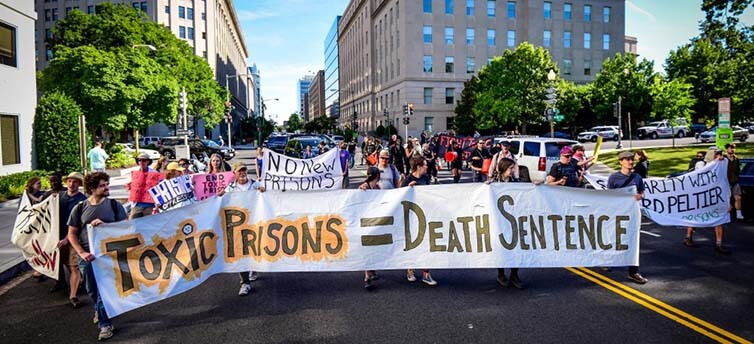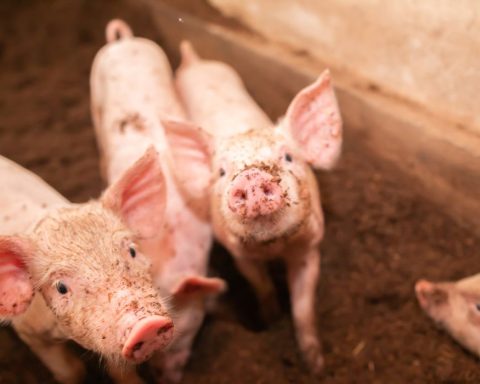Marcus Santos was a healthy man when he arrived at the State Correctional Institution (SCI) Fayette, a maximum-security prison in La Belle, Pennsylvania, in February 2012. But by the third year of his five- to ten-year sentence, Santos feared for his life. He’d developed a host of severe medical problems – skin rashes, partial vision loss, swelling in his throat – and worried whether he’d ever see his 13-year-old son again.
Santos, who kept detailed notes of his symptoms and underwent numerous emergency medical treatments over those first few years in jail, was eventually transferred to another facility, where his condition soon improved. Meanwhile, back at SCI Fayette, fellow prisoners were experiencing similar health struggles: not just routine headaches, dizziness, and fatigue but also respiratory illnesses, gastrointestinal tract problems, thyroid disorders, and cancers.
What could be causing such serious, widespread problems at SCI Fayette? Dustin McDaniel, executive director of the Abolitionist Law Center, puts it bluntly: “You look at a Google map of the prison and see how it’s surrounded by this coal ash dump – it’s just blindingly obvious that this is a really bad idea.” Through a yearlong investigation in coordination with the Human Rights Coalition, the law center, based in Pittsburgh about an hour from La Belle, found the alarming rates of illness among SCI Fayette’s prisoners to be consistent with exposure to coal ash. The prison’s immediate surroundings, according to the investigation’s 2014 report, No Escape: Exposure to Toxic Coal Waste at State Correctional Institution Fayette, include about 40 million tons of waste, two coal slurry ponds and millions of cubic yards of coal combustion waste. Findings like these have led a group of town members to challenge the polluters in court for violating state environmental regulations.
The problems at SCI Fayette are extreme, but they are not isolated. Prisoners across the country are too often trapped in toxic conditions – with contaminated drinking water and polluted air. Raw sewage leaks are common, and dozens of facilities, like SCI Fayette, are built on or next to mines, landfills and Superfund sites.
What’s more, the problems tend to be exacerbated by what McDaniel describes as “horrendous” health care services for people behind bars. “While ‘the Constitution does not mandate comfortable prisons,’ and conditions may be ‘restrictive and even harsh,’ conditions that are inhumane are impermissible under the Eighth Amendment’s prohibition against cruel and unusual punishment,” states the No Escape report. “When the government deprives an individual of his or her liberty via incarceration it possesses a corresponding duty to provide for that person’s basic human needs, including food, clothing, shelter, medical care and safety.”
America’s own “Gulag Archipelago”
Experts point to two major factors contributing to the troubles at SCI Fayette and beyond. The first stems from a national crisis – our country’s exploding incarceration rate, which has increased sevenfold over the past four decades. The nation’s unprecedented incarceration numbers, beginning in the 1970s, brought on a surge in prison-building, often in environmentally questionable areas. “We have 5 per cent of the world’s population [in the United States], but 25 per cent of the world’s prisoners,” observes Panagioti Tsolkas, director of the Prison Ecology Project (an initiative of the Human Rights Defense Center) as well as the Campaign to Fight Toxic Prisons (a collaboration with the Abolitionist Law Center). “This country has used prisons to maintain social inequality for decades.”
The second factor concerns the regional economic struggles of central Appalachia, America’s coal country, where state prisons abound and five new federal prisons have cropped up since 1992. McDaniel and Tsolkas have both referred to the area as our country’s own Gulag Archipelago. There, with the loss of mining jobs triggering residents to seek work elsewhere, and with rural populations shrinking, some government officials are turning to the prison industry as an economic salve.
That’s the case in Letcher County, Kentucky, where elected officials are trying to build a new federal prison on the site of a mountaintop removal coal mine. Today, the once forested mountaintop amounts to little more than a toxic dump, having been clearcut, blasted open, and mined for coal, surrounded by a heap of toxic debris and bisected by poisoned waterways. Sites like these – bare, flattened areas, filled with mining waste – have become permanent toxic scars on landscapes and communities throughout central Appalachia.
Congress approved the $444 million, 700-acre Roxana, Kentucky, prison project in 2015, a victory for Representative Hal Rogers, who has for more than a decade been selling this prison to his constituents as the answer to the area’s lost coal mining jobs. (Fox News dubbed the nearby town of Whitesburg—the Letcher County seat – “the poster child for the war on coal.”) And even though the U.S. Bureau of Prisons’ latest budget rescinds those funds, with the U.S. Department of Justice arguing that the recent 14 per cent decline in prison population doesn’t justify the construction of a new federal facility, Representative Rogers has kept up his attempts to strong-arm the project through.
“This is a common reality in what used to be thriving communities that are struggling to figure out what a just transition away from coal and the fossil fuel industry looks like for their residents,” says Sara Imperiale, an NRDC staff attorney who works on environmental justice issues. “Very often, elected officials tout the promise of economic growth and jobs associated with state or federal dollars earmarked for a new prison. In fact, those benefits are far from guaranteed, and residents often have creative, alternative visions for the promised resources and the future of their community that don’t feature a prison.”
Tsolkas notes that pressure from opponents has likely helped keep the Letcher County project at bay. Over the past three years, criminal justice advocates and community members alike have written letters, participated in public education forums, amplified prisoners’ concerns and gotten involved in the environmental review process. “We’ve seen a turn in the local community in Letcher County coming out against the prison,” he says. “[The U.S. Bureau of Prisons] even had to redo their environmental impact statement after a significant private landowner came out against it.”
Ada Smith, whose family has lived in Letcher County for generations, is also strongly opposed to Rogers’s pursuit of the project. “There needs to be some process for residents to have some say-so,” she says. “This prison is not a good economic solution or even opportunity for us, and I desperately don’t want to see one come. It’s a much bigger issue than whether we get 300 jobs or not.”
Smith, who works at a nonprofit media, arts and education center dedicated to revitalizing the communities of Appalachia, recently started an advocacy group called the Letcher Governance Project in response to the proposed prison. The group’s members work to call attention to the systemic racism that they say underpins mass incarceration; as Imperiale notes, people of color are disproportionately represented in federal prisons across the country. Letcher Governance Project members also believe that $444 million could be better spent on bringing other development to their area. A health care facility focused on mental health or drug rehabilitation would be a good place to start, Smith says, adding, “I think we have way more to offer this region, this state, this country than having a federal prison.”
The fight broadens
Although Tsolkas, Imperiale, McDaniel and Smith all see the Bureau of Prisons’ move to eliminate funding for a facility in Letcher County as a positive development, they are staying vigilant as to the bureau’s next move. The agency has repeatedly stated that the Letcher County facility would not pose any health or safety risks, indicating over the summer that its reason for cutting the funding was purely financial.
Meanwhile, the community and environmental justice advocates point to studies showing that people living near mountaintop removal sites are at increased risk of developing physical and mental health problems and of dying from cardiovascular disease and cancer. Concerns about the proposed Letcher site stem from an alarming set of tests on the property that have already shown the water system that would supply the prison is contaminated by high levels of fecal coliform bacteria and hepatitis A. The tests also indicate poor water quality in the area overall due to local industrial activities.
“We definitely have a lot of water quality problems in this area,” Smith acknowledges, explaining that the two main pollutants that plague eastern Kentucky’s waters, raw sewage and heavy metals, are a direct result of the coal industry’s activities in the region. Water pollution is a big health concern for residents throughout the Bluegrass State. Groups like Kentuckians for the Commonwealth are taking matters into their own hands by promoting community water monitoring programs while fighting for a just economic transition away from coal – with a focus on sustainable energy – in Appalachia. And the $444 million in federal funds allotted for the Letcher County prison could certainly go a long way in building more sustainable clean water infrastructure in the region, advocates say.
Through official comments to the Bureau of Prisons, the Human Rights Defense Center, the Abolitionist Law Center and other groups have detailed the potential hazards to prisoners and encouraged the bureau to rethink the Letcher County project. They’ve also made it clear to the bureau that they’re in this fight for the long haul. “They know that groups are gearing up for possible litigation if they pass it,” Tsolkas says.
After three rounds of revised environmental impact statements – which, notably, are required to consider the health of nearby residents, but not that of prisoners – everyone is stuck playing the waiting game for the Bureau of Prisons to issue its “Record of Decision.” Meanwhile, Rep. Rogers and the bureau continue to battle over the funding issue as Congress works on finalizing the 2018 budget.
As all of this political drama plays out, McDaniel and Tsolkas continue to tell the stories of the inmates at SCI Fayette and at environmentally unsound prisons across the country. It is to these incarcerated men and women that they devote their work. Tsolkas is cautiously optimistic that their opposition to Letcher could mark a positive shift in the fight for environmental justice – and for those trapped by the country’s system of mass incarceration, as well as for the employees staffing toxic prisons. Currently, his group is working with students and academic professionals on a mapping tool that will spotlight environmental injustices happening at prisons around the country.
“Until recently it’s been difficult to make any headway in questioning or challenging the prison system,” Tsolkas says. “We’re putting a face on the movement by getting people out on the streets together, getting people to meet each other and to cross those lines between environmental activists and prisoner rights advocates.” A victory for these newfound allies in Letcher County would represent a major step in the fight to unmask toxic prisons nationwide.
This article originally appeared in onEarth







